#messy sketches for mental integrity
Explore tagged Tumblr posts
Text
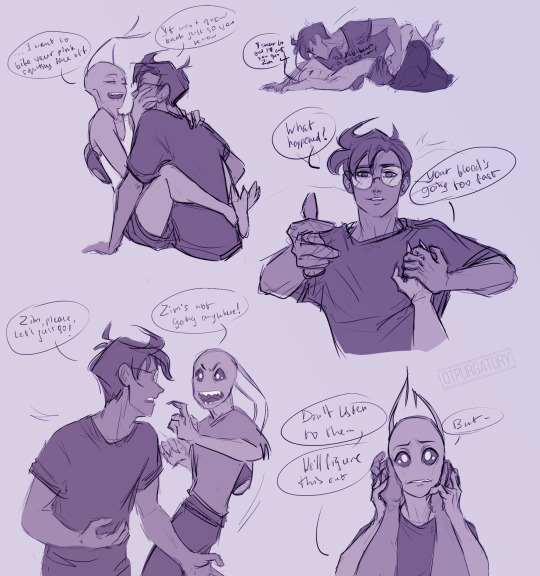
forever ZADR doodles yo
#zadr#invader zim#dib membrane#zim#invader zim fanart#invader zim dib#messy sketches for mental integrity
519 notes
·
View notes
Text
Once again, I can't really gather my thoughts cohesively on this right now, so please bear with me. Just musing, so the ideas here might be a bit disconnected.
As a prodigy artist well-versed in more than just singing, it's no suprise that art is a prominent part of Till's character. Everything associated with Till seems to carry his eccentric artistic talent, right down to the abstract symbols painted onto his otherwise blank white t-shirt.




(Till's sketching and drawing seem to go hand-in-hand with his songwriting. Doodling and composition are two of his hobbies, and he's stated to be talented at both.)

(His appearance in TOP 3 emphasizes this messy, artistic angle. The symbols painted on the wall are similar to graffiti tags, usually associated with youth and rebellion. Furthermore, there is paint splattered on his face, staining color onto his disheveled hair and baggy clothes.)


(Even amongst the TOP 3, Till is presented with the most color. Between Luka and Ivan's main colors of white and black, their formal attire and elegant, charming personas, Till looks rather out of place.)

(Till's personal/special talent is floral art.)
Art is an integral part of Till's character, something that defines him and his desire for self-expression and freedom (it's no suprise that when Till loses his will to live in ROUND 6, he's dressed in plain and monochromatic clothes that lack any of his own artistic touch). Despite the ties between creativity and freedom, Till's talents are regularly taken advantage of and even tampered with due to the treatment he receives from his owner.
Guardian Urak is an eccentric segyein. A hustler, materialistic and rather pretentious. He shows great pride in Till's "uniqueness" and artistic ability, boasting that he has raised the best human-pet in history. In order to create the success that is Till, however, Urak had to execute his methods on several other pets beforehand. His practices include the thorough abuse of his human pets in order to coax out their talents, pushing them to their limits with harsh training regimens and painful experiments. Violence is a tactic utilized heavily within Urak's line of business, and the human pets under his ownership are the most openly abused.
Urak is said to abuse his pets to the point of severe mental issues. It's due to these mental issues that his previous pets have failed to achieve victory, showing great promise but never making it to the end. He seems to believe in the idea that the peak of a human's talent is tied with their instability, that the more talented a pet human is, they more likely they are to be a freak.

Urak pushes forward with the mistreatment of his humans despite their suffering. He believes it to be a part of creating exemplary art, playing into the idea of a tortured artist. Urak's pets were incredibly talented and top contenders for the title of champion. If not for their heavily deteriorated mental states, they would have brought Urak to victory long ago. It's quite clear that he does not intend on changing his methods because the humans he produces are some of the best products around. He doesn't want to change his methods, he wants a human that can withstand them.
Till's style is already established to be unique, nicknamed a "black sheep" in his official magazine page, emphasizing individuality. His brazen aggression in ROUND 2 caused him to attract much hate, but twice as many fans, too. The bashing of Freddie was framed as a bombastic and somewhat avant-garde performance act, referred to as art. Till's public persona was that of an eccentric and unpredictable artist, a highly reactive contrarian pet who presents both a high risk and high reward. Urak has produced another tortured artist, except this one is different (in his words, unrivaled). A higher caliber of pet, bringing him the closest to winning he's ever gotten thus far.
Till's various artistic talents seem to be things that he has developed on his own, stemming from his own desires and interests rather than something forced onto him by Urak. In one of VIVINOS and QMENG's livestreams it was stated that Till is inherently gifted, a creative genius since birth. Till uses his abilities as tools of rebellion and self-expression, writing his own music, vandalizing and adjusting segyein-provided material and outfits in order to make them more his own. It's unfortunate that even Till's attempts at rebellion are taken advantage of and instead used against him. Constantly battered and bruised, isolated in a cell, forced to endure experimentation, all of his artistic ingenuity and creations have been taken by the segyein and used to promote him as a product. He has been turned into a spectacle, his misery and abuse put on display for others to gawk at. Suffering for the sake of art.
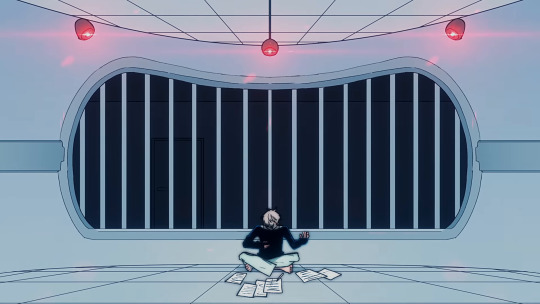
#sorry i dont know if this makes any sense ummm#alnst#alien stage#alien stage till#alnst till#till alien stage#para.musing
384 notes
·
View notes
Note
if I’ve already sent this ask before I’m so sorry, I’ve got adhd, but how did you find your art? (I’m in my questioning phase)
hihi!!! no problem! i think i have some kind of glitch with asks bc when i go look for them it says i have 3, but when i check it, there isn’t any so im sorry if any of u have ever sent asks and i havent answered them it’s probably bc of that😭
but anyways lets get on it!
finding you art style is not smth simple at ALL. ive been drawing my entire life!!! and ive had a bunch of different styles until now, they kinda used to change every few months or so, i was always happy with them but it never really lasted??? and i always had at least one part of the process of it to dread doing, for example, coloring.
it wasn’t until recently i FINALLLYYY found a style im 100% comfortable in.
it really takes experimenting and finding what elements of creating art you love and enjoy the most. for me, i used to mostly do traditional art, just pencil or ink sketching and i would OCCASIONALLY color them. so i really used to enjoy kinda the messiness of the pencil on trad mediums and stuff? and i never rlly found a way to translate that element to digital art which is the one i enjoy the most now.
brushes are very important! it depends on the look you like. since i like that pencil feel, i use a pencil looking brush! (softy from esbenlash’s procreate brush set) and i also got a paper feel screen protector for my ipad to enhance the experience🔥
i found i mostly enjoyed doing lineart and didnt rlly look forward to coloring, i didnt find my past styles enjoyable bc they kind of felt restricting in that area? since i didnt find a way to make it more abt the lineart and less abt coloring that i liked (ofc theres plenty! i just didnt find one for me)
so tbh i think what mostly influenced the style i enjoy the most now is film, and baroque art!
i had recently seen:
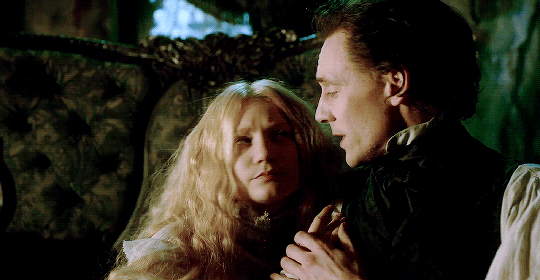
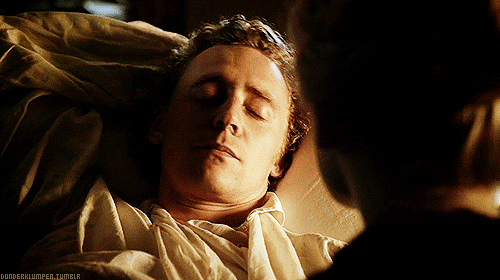
Crimson Peak (2015)
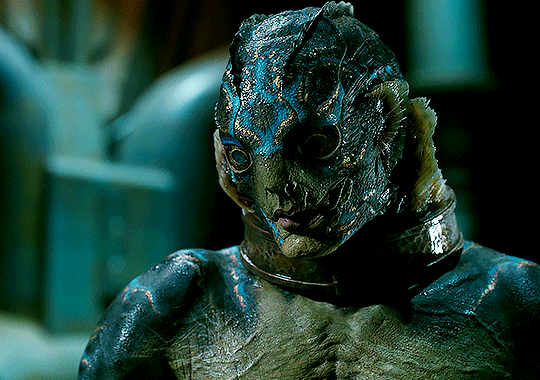
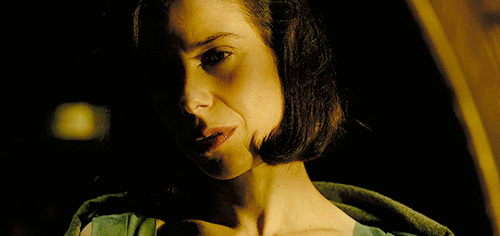
The Shape of Water (2017)
and ofc


Stranger Things DUHHHHH
and i fell in love with the way the lightning was, heavy dark shadows and moody lights, and tried to match my style to it and found that it highlighted all the things i enjoy doing the most while drawing! so thats where i am now
special mention to the one movie im obsessed with currently


The Crow (1994)
also has the similar style
all that + experimenting, studying other’s art i liked and finding elements to integrate to my art, ANDDD music also played a huge part in it. so as you can see for me its about kind of combining aspects of every single piece of media i like 😭
its not gonna be the same for everyone, but its always good to have a guide so i hope this was useful for you and anyone else! im always willing answer any art questions :)
don’t worry too much about speeding up finding your style, it’ll come to you eventually, so focus on enjoying the moment and learning, take mental notes of what you like and don’t like!
sorry this is kinda long as hell… but i like rambling
#perfect opportunity to show off these shots from my fav movies teehee#art truly is all one!#i love getting inspired from multiple medias and combining it into drawing#ari answers asks
20 notes
·
View notes
Text
Hey, Extroverts! Here are 7 Reasons Alone Time Really Is Important for You
New Post has been published on http://foursprout.com/health/hey-extroverts-here-are-7-reasons-alone-time-really-is-important-for-you/
Hey, Extroverts! Here are 7 Reasons Alone Time Really Is Important for You
Being constantly busy with zero alone time seems perfect for the extrovert—and if you consider yourself one, you probably have a tendency to overpack your schedule, maintain a full social calendar, and attend social gatherings on days that don’t start with an F or S. But extroverts need alone time too, for a whole host of reasons. But before we get into all that…
What exactly are extroverts and introverts? And what the heck is an ambivert?
According to famed psychoanalyst Carl Jung, who coined the term in in his book, Psychological Types, extroverts get their energy from being around people—from being social—while alone time can result in feelings of loneliness. “Some of my extroverted patients have to constantly be doing things,” says clinical psychologist Anthony Mullen, Ph.D. “When everything stops, they start to shut down and feel alone.”
Conversely, introverts reset and re-energize away from other people; they typically need to recharge alone. The introvert is probably the first person to leave a party; they usually feel more comfortable away from high-energy, loud crowds and avoid big, people-packed events like the plague.
EDITOR’S PICK
displayTitle
Of course, most people aren’t one or the other—they fall somewhere on the spectrum. “A healthy, well-integrated person has aspects of both extroversion and introversion,” Mullen says. The majority of us are actually ambiverts, which means we have characteristics of both. If you’re curious as to where you fall on the spectrum, your Myers-Briggs can map your personality type.
Being extroverted seems like it’s an easier way to live life, right? To start with, when being around people recharges you, you’re more likely to have an easier time making friends. One study even found a strong link between extraversion and happiness. But this strength can also be a weakness: Extraverts tend to stay as busy as possible. As Mullen says, “There is an implicit idea that it’s bad to be alone.”
So what happens when extroverts don’t get alone time?
From personal experience, you can end up with messy, unwashed hair; no time for the laundromat; and chipped nail polish. But more importantly, overexerting yourself can leave you exhausted and stressed.
Everyone needs downtime: We all need to sleep and engage in the self-care activities that keep us healthy. If we’re constantly with people and leave no time for ourselves, we can become burnt out, emotionally and physically, and even display extremes in behavior. Personally, I was once so overwhelmed and exhausted that I definitely burst into tears when they were out of my favorite dark chocolate marzipan bar at my local bodega. That’s kind of extreme.
“You could be overstimulated to the point where you could feel psychotic or manic,” Mullen says. “Before that, you might feel exhausted, depressed, and perhaps anxious.”
“Time alone—free from technology and goal-oriented activity—is beneficial to extroverts, introverts, and everyone in-between,” says New York City-based psychologist Sevan Basil, Ph.D. “The main difference is that solitude doesn’t feel vital to the daily emotional survival of an extrovert the way it does to an introvert.”
So what are the benefits of alone time for extroverts?
1. Finding time to truly discover ourselves.
It’s good for extroverts to learn who they are—away from the crowd. What are our goals? If we typically go along with things just because that’s what the rest of the group is doing, alone time can help us understand our wants and needs, likes and dislikes, and properly cultivate our understanding of ourselves.
“Time alone is important because it provides an opportunity to become better acquainted with ourselves,” Basil says. “In the hustle and bustle of everyday life, it can be difficult to stay in touch with our inner worlds—our thoughts and feelings—because of the strong pull exerted by the external world: work, family responsibilities, and social commitments. The thing is, the more alienated we are from our inner worlds, the less freedom we have to be intentional and authentic in our choices, large and small.”
2. Gaining a newfound appreciation for the quality people in our life.
With time to reflect, we can gain a new perspective about who the really awesome people in our life are—the folks that push us positively and make life a little brighter. “I’d encourage all people to take time to reflect on how different relationships impact them, emotionally and psychologically,” Basil says.
“Not all relationships are nourishing. Perhaps introverts are more naturally inclined toward this, though, knowing intuitively that their reserves for socializing are limited. This is something anyone can learn to do, by getting into the habit of paying attention to how they feel during and after their time with friends.”
3. Taking time to make positive changes (or tap into our creative sides).
“By slowing down and making space for solitude, we are in a sense making a commitment to not flee from ourselves,” Basil says. “Amazing and terrifying things can happen when we are alone with ourselves in this way: We might pick up a book that shifts our worldview, notice the tree outside our bedroom window for the first time and feel inspired to sketch it, or invent a delicious new recipe with the five ingredients left in the fridge.”
4. Processing emotions we wouldn’t normally explore.
When we’re alone, the experience isn’t always fun—but it’s still important, Basil says.
“We might experience unpleasant feelings that have previously been warded off by our business, sadness connected to a loss, feelings of inadequacy we don’t allow ourselves to speak about, or ambivalence about a romantic commitment,” she says. “We might be forced to confront unhealed emotional wounds, both recent and longstanding.”
While these are difficult aspects of life to consider—even scary, in the moment—it’s a worthwhile endeavor. “A problem can only be solved if its presence is first acknowledged,” Basil says.
5. Practicing self-care.
Sure, it’s a buzzword, but self-care is also really, really important—especially for folks who spend a lot of time taking care of other people and don’t focus enough on themselves. “When you’re alone, you’re not bothered by others’ needs—or you don’t have to be. So you can take that nap, be energized by doing your yoga at home, or do absolutely nothing,” Mullen says.
6. Beating the social media blues.
If you’re the kind of extrovert who procrastinates (or just stays awake way too long) by hanging out on social media excessively, then this one’s for you. One study found that using written social media platforms is “negatively associated with positive mental health variables and significantly positively with depression, anxiety, and stress symptoms.” And social media use can delay your reduction of cortisol levels—which leads to you feeling stressed out, according to another study. So when you’re home alone, if you can just hit the power button on that phone of yours and chill out genuinely alone, you’ll feel way better.
7. Finding ways to feel less stress overall.
Putting our own needs ahead of others’ and not worrying about pleasing other people all the time lowers stress levels immensely. Stress less about demands, others’ expectations, and pleasing people. “Some people feel that their social calendars just ‘fill up’ out of their control and end up feeling sapped by this over-scheduling, but can’t seem to change,” Basil says.
“Although they might start out thinking of themselves as an extrovert, it’s possible that through intentional time alone, they’ll discover that solitude feels more energizing and enriching than reflexive socializing for them—and that maybe they were more introverted than extroverted all along!”
Alone time isn’t so scary. Maybe it’s time to ditch that Saturday night party and put the kettle on.
Kari Langslet is an avid dater, impulsive adventurer, unofficial therapist to friends and family, and animal lover. You’ll usually find her at a dive bar playing Jenga with her dog or headbanging into oblivion at a Brooklyn show. Stalk her on Instagram and Twitter @karilangslet.
0 notes
Text
Hey, Extroverts! Here are 7 Reasons Alone Time Really Is Important for You
New Post has been published on http://foursprout.com/health/hey-extroverts-here-are-7-reasons-alone-time-really-is-important-for-you/
Hey, Extroverts! Here are 7 Reasons Alone Time Really Is Important for You
Being constantly busy with zero alone time seems perfect for the extrovert—and if you consider yourself one, you probably have a tendency to overpack your schedule, maintain a full social calendar, and attend social gatherings on days that don’t start with an F or S. But extroverts need alone time too, for a whole host of reasons. But before we get into all that…
What exactly are extroverts and introverts? And what the heck is an ambivert?
According to famed psychoanalyst Carl Jung, who coined the term in in his book, Psychological Types, extroverts get their energy from being around people—from being social—while alone time can result in feelings of loneliness. “Some of my extroverted patients have to constantly be doing things,” says clinical psychologist Anthony Mullen, Ph.D. “When everything stops, they start to shut down and feel alone.”
Conversely, introverts reset and re-energize away from other people; they typically need to recharge alone. The introvert is probably the first person to leave a party; they usually feel more comfortable away from high-energy, loud crowds and avoid big, people-packed events like the plague.
EDITOR’S PICK
displayTitle
Of course, most people aren’t one or the other—they fall somewhere on the spectrum. “A healthy, well-integrated person has aspects of both extroversion and introversion,” Mullen says. The majority of us are actually ambiverts, which means we have characteristics of both. If you’re curious as to where you fall on the spectrum, your Myers-Briggs can map your personality type.
Being extroverted seems like it’s an easier way to live life, right? To start with, when being around people recharges you, you’re more likely to have an easier time making friends. One study even found a strong link between extraversion and happiness. But this strength can also be a weakness: Extraverts tend to stay as busy as possible. As Mullen says, “There is an implicit idea that it’s bad to be alone.”
So what happens when extroverts don’t get alone time?
From personal experience, you can end up with messy, unwashed hair; no time for the laundromat; and chipped nail polish. But more importantly, overexerting yourself can leave you exhausted and stressed.
Everyone needs downtime: We all need to sleep and engage in the self-care activities that keep us healthy. If we’re constantly with people and leave no time for ourselves, we can become burnt out, emotionally and physically, and even display extremes in behavior. Personally, I was once so overwhelmed and exhausted that I definitely burst into tears when they were out of my favorite dark chocolate marzipan bar at my local bodega. That’s kind of extreme.
“You could be overstimulated to the point where you could feel psychotic or manic,” Mullen says. “Before that, you might feel exhausted, depressed, and perhaps anxious.”
“Time alone—free from technology and goal-oriented activity—is beneficial to extroverts, introverts, and everyone in-between,” says New York City-based psychologist Sevan Basil, Ph.D. “The main difference is that solitude doesn’t feel vital to the daily emotional survival of an extrovert the way it does to an introvert.”
So what are the benefits of alone time for extroverts?
1. Finding time to truly discover ourselves.
It’s good for extroverts to learn who they are—away from the crowd. What are our goals? If we typically go along with things just because that’s what the rest of the group is doing, alone time can help us understand our wants and needs, likes and dislikes, and properly cultivate our understanding of ourselves.
“Time alone is important because it provides an opportunity to become better acquainted with ourselves,” Basil says. “In the hustle and bustle of everyday life, it can be difficult to stay in touch with our inner worlds—our thoughts and feelings—because of the strong pull exerted by the external world: work, family responsibilities, and social commitments. The thing is, the more alienated we are from our inner worlds, the less freedom we have to be intentional and authentic in our choices, large and small.”
2. Gaining a newfound appreciation for the quality people in our life.
With time to reflect, we can gain a new perspective about who the really awesome people in our life are—the folks that push us positively and make life a little brighter. “I’d encourage all people to take time to reflect on how different relationships impact them, emotionally and psychologically,” Basil says.
“Not all relationships are nourishing. Perhaps introverts are more naturally inclined toward this, though, knowing intuitively that their reserves for socializing are limited. This is something anyone can learn to do, by getting into the habit of paying attention to how they feel during and after their time with friends.”
3. Taking time to make positive changes (or tap into our creative sides).
“By slowing down and making space for solitude, we are in a sense making a commitment to not flee from ourselves,” Basil says. “Amazing and terrifying things can happen when we are alone with ourselves in this way: We might pick up a book that shifts our worldview, notice the tree outside our bedroom window for the first time and feel inspired to sketch it, or invent a delicious new recipe with the five ingredients left in the fridge.”
4. Processing emotions we wouldn’t normally explore.
When we’re alone, the experience isn’t always fun—but it’s still important, Basil says.
“We might experience unpleasant feelings that have previously been warded off by our business, sadness connected to a loss, feelings of inadequacy we don’t allow ourselves to speak about, or ambivalence about a romantic commitment,” she says. “We might be forced to confront unhealed emotional wounds, both recent and longstanding.”
While these are difficult aspects of life to consider—even scary, in the moment—it’s a worthwhile endeavor. “A problem can only be solved if its presence is first acknowledged,” Basil says.
5. Practicing self-care.
Sure, it’s a buzzword, but self-care is also really, really important—especially for folks who spend a lot of time taking care of other people and don’t focus enough on themselves. “When you’re alone, you’re not bothered by others’ needs—or you don’t have to be. So you can take that nap, be energized by doing your yoga at home, or do absolutely nothing,” Mullen says.
6. Beating the social media blues.
If you’re the kind of extrovert who procrastinates (or just stays awake way too long) by hanging out on social media excessively, then this one’s for you. One study found that using written social media platforms is “negatively associated with positive mental health variables and significantly positively with depression, anxiety, and stress symptoms.” And social media use can delay your reduction of cortisol levels—which leads to you feeling stressed out, according to another study. So when you’re home alone, if you can just hit the power button on that phone of yours and chill out genuinely alone, you’ll feel way better.
7. Finding ways to feel less stress overall.
Putting our own needs ahead of others’ and not worrying about pleasing other people all the time lowers stress levels immensely. Stress less about demands, others’ expectations, and pleasing people. “Some people feel that their social calendars just ‘fill up’ out of their control and end up feeling sapped by this over-scheduling, but can’t seem to change,” Basil says.
“Although they might start out thinking of themselves as an extrovert, it’s possible that through intentional time alone, they’ll discover that solitude feels more energizing and enriching than reflexive socializing for them—and that maybe they were more introverted than extroverted all along!”
Alone time isn’t so scary. Maybe it’s time to ditch that Saturday night party and put the kettle on.
Kari Langslet is an avid dater, impulsive adventurer, unofficial therapist to friends and family, and animal lover. You’ll usually find her at a dive bar playing Jenga with her dog or headbanging into oblivion at a Brooklyn show. Stalk her on Instagram and Twitter @karilangslet.
0 notes
Text
An Artist’s Balancing Act: Projects, Practice, and Those Poorly Timed and Poorly Formed Mental Images
You know what I’m talking about.
You’re trying to fall asleep for the millionth time when you have a flash of an idea. Do you get out of bed and draw it? Do you write it down and hope that in your almost-asleep stupor you’re able to write something descriptive enough to really remember the idea in the morning? Maybe you try to draw it, but it’s not even close to a fully formed idea - it was, after all, just a flash of an idea.
And while you have these moments of inspiration, can you actually draw them? Do you know how to draw only people? Can you draw only animals? Will that sweeping landscape you pictured just end up looking like lumps on a poorly drawn log?
That is of course where the dreaded practice comes in. We all like the idea of practice, but who really wants to make themselves practice when they could draw the real thing?! Or in theory, draw the real thing. Because maybe you don’t have the skills yet.
OR maybe you do. But you’ve started too many projects at once, which will take more time than a sketch or thought out doodle. You’re busy and you don’t take time for practice nor for those flashes of inspiration. You’ve got things to do!
I think there’s a fine balance here, and so many artists (myself so very much included) don’t know how to achieve such a balance.
So here’s the bad news: honestly, I can’t really tell you how exactly to achieve said balance. No one can, in fact. I don’t have a magical schedule with a special formula for sticking to it and neither does anyone else. But I’ve been coming to realize the importance of exercising all three (inspiration/sketching, practice, & finished projects), and I think that with time anyone can learn to integrate all three better. So instead of a steadfast guide, here are a few suggestions:
(1) Inspiring Sketchbook: Those flashes of inspiration are important. If you’ve had an idea and love it, even lacking a full form, I’d bet you it’s good. So keep a small sketchbook with you (have it on your person as often as possible - with a pen or pencil, of course). Draw messy sketches in a flash. Write down notes. You shouldn’t care about how it looks as long as you think you’ll understand the idea later. If you don’t have your sketchbook, write as descriptive of a note as you need in your phone and add it to your sketchbook when you can. Later, when inspiration doesn’t strike, you can open those little sketchbooks full of half-formed ideas and you might just find exactly what you need.
(2) A Schedule: What’s the schedule for? Well, figure out when you’ve got extra time and start practicing - regularly. The specifics of scheduling it are up to you, just make sure it’s consistent and probably weekly at least. Don’t know what to practice? The internet is full of prompts. Tumblr has pages dedicated just to giving drawing prompts. Or there’s the Twitter feed of Sketch Dailies. Or maybe you want to work on something particular instead of an idea or character. Try Line of Action’s human models if you want to draw people better. If you want to draw hands better, this link to a selection of 3D models, which you can move at any angle, might be a good starting point (but beware, if you care, the model that first loads when you open it is not a hand, but a nude male torso). Want to practice a particular technique? Find a tutorial or try to copy images of people who use those techniques/materials (as long as you don’t take credit for their creativity). Or maybe you want to draw a particular kind of animal. Do a Google image search and just draw through a variety of images (or, as I saw an artist do, search something like #cats on instagram and draw what you find).
The ideas are endless. Just make sure that you start out with loose images and work into something more finished. Don’t commit all your time to this either. Set a timer to let you know when it’s been 15 minutes or and maybe another for 30. Do something that works for you as long as it lets you practice sometimes.
(Oh, and make sure you can balance your practice schedule with your projects and non-art responsibilities!)
(3) Warm Up: No, not by a fire, though that might be nice too. Warm up by loosely sketching something before you get into your project(s). It really does help if you do some of this time of practice, as it can get you into the mood and out of the place of OH CRAP, I NEED TO MAKE ART AND IT MUST BE BRILLIANT. Just start with something small, preferably related to what you’re planning to work on, and don’t let yourself get too far into it - you’ve got a project that needs working on after all!
(4) Inspiration Tracking: Yeah, tag those inspirations before you set ‘em free back into the wild so you can find them again later. Kind of. What I mean is find a way to keep track of what inspires you. This will help with the projects, practice, and inspiration sketchbook keeping. I have tags on one of my other Tumblrs where I track art that I really like the style of, ideas/photos that inspire me, and art that I like in general. These help me later when I’m wanting something to draw, be it for practice, a project, or simply something to add to my inspiration journal for later.
(5) Projects for You & Projects for Me: Sometimes you create specifically for you. Sometimes you create specifically for others. Sometimes it’s both. Just make sure that you’re always doing some of both. You can burn yourself out if you don’t draw for yourself. Not every project you do should be for someone else, even if you enjoy it. Make time to draw things only for you and furthermore, let those drawings for your be awful sometimes. When you create without restraint for yourself, sometimes it’s awful and that’s okay. You don’t have to share it. It’s your own personal practice, in a way. Keep it up. :)
#artist problems#inspiration#practice#art projects#an artist's balancing act#thoughts on art#sketchblog blogging#the hopeful update
0 notes